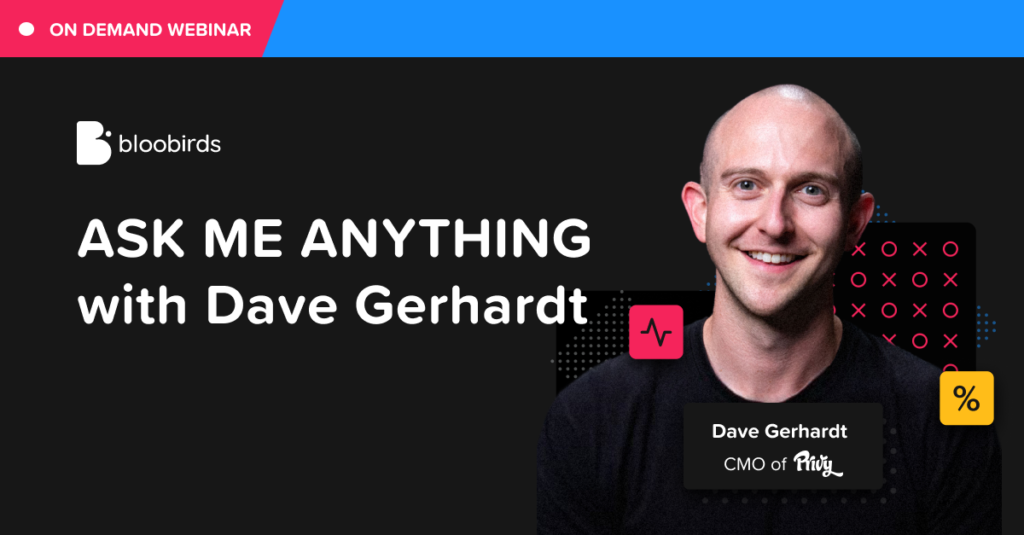For those of you who were not able to tune into last week’s insightful webinar with Privy’s Chief Marketing Officer Dave Gerhardt, we have you covered! We at Bloobirds brought together the key takeaway messages from the live Q&A so you can get bang for your buck from your SaaS marketing strategy.
If you’re looking to shift your messaging to resonate with your audience in these difficult times, then keep on reading below. Dave’s practical advice will help you to maximize return on investment through this unprecedented season and keep you riding strong.
The Take-Away Messages
The 2-step strategy to fight any recession
The current times are unsettling. Market figures rise and fall, and companies continue to see their workers working from home. So, what can marketing do to fight off any repercussions of an economic decline?
According to Dave Gerhardt, it’s as simple as following two tactics: copywriting and owning your audience. It’s not about making the right copy or finding the right audience per se. It’s about making the copy right for the audience right in front of you!
Do you catch the difference?
The companies who can be more creative with their copy and make the most of email lists (owning your audience) will win the competitive advantage.
You could be saying, “Well, yea, but how does my company fit into this equation? We’re in the travel industry and business is just not happening.”
You’re right. Business is just not happening.
But there are still potential and existing customers, who are going through emails and social media constantly because of these times. This is your opportunity to build your audience, add value, and connect with them more than ever before.
Only one SaaS marketing metric matters
In the world of marketing, there is an overflow of metrics. Podcast downloads, social media engagement, number of followers, etc. But when you really come to think of it, only one metric matters – revenue.
If your marketing department cannot show how its actions impact your company’s revenue, then its strategy and tactics have fallen short.
Now, of course, every company is different and unique. Your sales processes may make it extremely tough for marketing to own revenue. That doesn’t mean, however, that you can’t use a proxy metric such as pipeline to measure success.
Look at Privy, for example. The company boasts a high-velocity freemium funnel. While the marketing division focuses on revenue, it also works with a sales team. When individuals become customers of Privy, where does the revenue come from? How can marketing know if they’re generating these numbers?
In this case, taking into account sales-assisted and touchless revenue, plus leading indicators like weekly traffic, weekly conversion rate, traffic-to-visitor conversion rate, and free-to-pay customer rate, can help clarify those doubts.
The ideal scenario for SDRs in marketing
In last week’s webinar with Trish Bertuzzi, we asked her a question that comes up again and again: who should own SDRs in a SaaS company? And we decided to put Dave Gerhardt on the spot and get his opinion on the matter.
As Dave remarked, it is quite clear when the marketing department should own SDRs –
- In a high-volume model
- Your SDRs are qualifying leads and passing them to sales
- Revenue and pipeline are your key metrics
If you approach the question from the standpoint of revenue, then owning SDRs in marketing means owning more of the revenue piece. Doing just that helps marketing prove their worth as a division in the company.
Multi-faceted means multiplied benefits
An economic downturn does not have to keep you down for the count as a marketer. On the contrary, with many in lockdown and an ample amount of free time, this can be your chance to explore those side projects that you always had in mind.
It’s what Dave himself highlighted in a recent post on LinkedIn, and reiterated in this webinar. When you let your curiosity take you to uncharted territories, you play with elements that you normally wouldn’t be able to in your day-to-day job.
In this sense, you’re not only fulfilling another passion of yours but also improving your skill sets as a marketer.
See, the thing is: a side project follows another set of rules, that is, your rules. Here, you can test different ideas and concepts; ask questions; see what works; make mistakes, etc. Your side project can be used as a testing lab for your day job.
Use the feedback you gain to build better actions and tactics in your 9-to-5 marketing strategy and drive the one metric that matters most – revenue.
—
If you enjoyed these highlights from our live session with Dave Gerhardt, we encourage you to check out the webinar in its entirety.
Want to check out more of our latest content? Read more articles.

